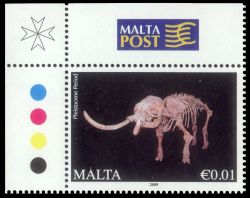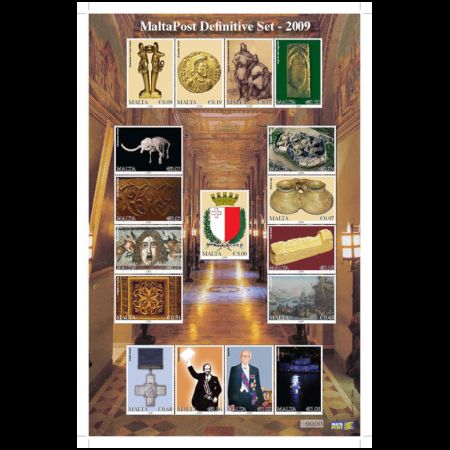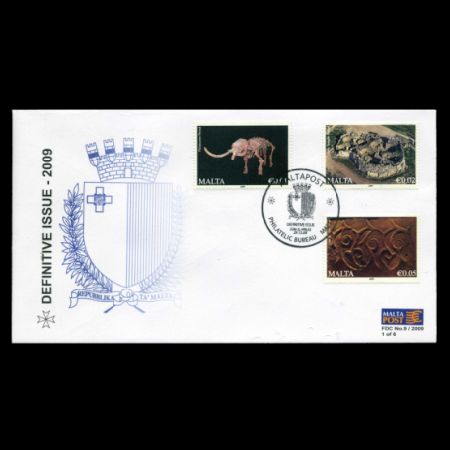Malta 2009 "Definitive issue 2009"
| <prev | back to index | next> |
| Issue Date | 29.12.2009 |
| ID | Michel: 1612-1628, ; Scott: 1383-1399; Stanley Gibbons: 1638-1654, MS1655; Yvert et Tellier:, BF44A; Category: pF |
| Design | Edward Pirotta and Paul Psaila |
| Stamps in set | 17 |
| Values |
1c - Skeleton of Prehistoric animal (Pleistocene Epoch) 2c - Ruins of stone temple (Early Temple Period) 5c - Carved stone pattern (Late Temple Period) 7c - Pair of Pots (Bronze Age) 9c - Gold statue (Phoenician and Punic Period) 10c - Mosaic (Roman Period) 19c - Gold coin (Byzantine Period) 26c - Fragment of carved stone (Arab period) 37c - Painting (Norman and Hohenstaufen Period) 50c - Stone tablet carved with shield (Angevin and Aragonese Period) 51c - Gold pattern with central Maltese Cross (Knights of St. John) 63c - Painting of officers and crew disembarking in rowing boats from ships (French Period) 68c - George Cross (British Period) 86c - Independence 1.00 - Republic 1.08 - EU Accession 5.00 - Arms of Malta |
| Emission/Type | definitive |
| Issue place | |
| Size (width x height) | stamps: 44 mm x 31 mm, Se-tenant Sheet: 169 mm x 263 mm |
| Layout | Mini-Sheets of 10, Se-tenant Sheet of entire set of 17 stamps |
| Products | FDC x6, PP x1, Se-tenant Sheet x1 |
| Paper | Maltese Cross watermarked |
| Perforation | 14 x 14 |
| Print Technique | offset |
| Printed by | Printex Ltd |
| Quantity |
Se-tenant Sheet - 11.500 (numbers: 000001 to 007500) €0.01 (fossil) - 400.000 stamps (40.000 sheets with numbers: 000001 to 040000) |
| Issuing Authority | Malta Post plc |

On February 28th, 2009, the Post Authority of Malta issued the set of 17 definitive stamps with face values from 0,01€ to 5,00€.
Later some stamps were reprinted:
- €0.01 - 19 October 2011, 21 April 2015
- €0.19 - 14 May 2011
- €0.37 - 19 October 2011
- Miniature sheet - 23 May 2011
The set tracks Malta's historical phases and milestones by depicting their related iconic images.
This remarkable set of stamps offers a philatelic and historical timeline while also confirming that a small postage stamp can succinctly tell a major storysaid Joseph Said, Chairman, MaltaPost p.l.c.
To celebrate this new Definitive Set, MaltaPost, in collaboration with Midsea Books Ltd, published a book titled "The Historical Collection Celebrating Malta's Heritage Through Stamps". The book, was released on December 29th, 2009, narrates Malta's history through a number of essays by specialist historians. The combined, numbered, Sheet with all 17 stamps was included in the first 2,500 numbered copies of the book. Both the Sheet and the book bear a matching serial number.
 A fossil skeleton of the dwarf elephant, Elephas falconeri is depicted on one
of the stamps with a face value of Euro cent 1 (€0,01).
A fossil skeleton of the dwarf elephant, Elephas falconeri is depicted on one
of the stamps with a face value of Euro cent 1 (€0,01).This fossil was found in the Ghar Dalam Cave which is located on the outskirts of Birzebbuga, Malta. The cave contains remains of animals that were stranded and subsequently went extinct on Malta at the end of the Ice Age.
Dwarf elephant, hippopotamus, deer and bear bone deposits found there are of different ages; the hippopotamuses became extinct about 180.000 years ago, whilst the deer species became extinct much later, about 18.000 years ago. It is also here that the earliest evidence of human settlement on Malta, some 7.400 years ago, was discovered.
The cave was first scientifically investigated in 1885, but was not opened to the public until 1933. It was used as an air-raid shelter during World War II. A museum was set up on site by the then curator of Natural History Dr. J.G. Baldacchino. In 1980, the most important and irreplaceable relics such as four tusks of dwarf elephants and the skull of a Neolithic child were stolen from the museum.
The cave was investigated in 1987 under the direction of Emanual Anati, Professor of paleontology at Lecce University. His team of Italian archaeologists from Centro Camuno di Studi Preistorici discovered Palaeolithic cave art depicting human hands, Anthropomorphic, and several animal designs from underneath the stalagmitic formations. Some depict elephants which have been extinct in the Maltese region since the Pleistocene.
Many stamps from the set, including the dwarf elephant, were reprinted in the coming years.
Reprinted stamps have some design differences, for example the logo of Malta Post at top-left part of a Mini-Sheet.

The original stamp (on left) and reprinted stamps from 2011 (middle) and 2015 (on right).
Products and associated philatelic items
| Official FDC | Combined Sheets | Set of Mini-Sheets |
 |
 |
 |
| Official FDC with fossil stamp | Mini-Sheet with fossil stamp | Presentation Pack |
 |
 |
 |
| Examples of Circulated Covers | ||
 |
 |
|
| A cover with the fossil stamp from the first reprint in 2011, posted to Germany in 2012. | ||
References

|
- Technical details and official press release:
Malta Post, Presentation Pack. - Elephas falconeri / Palaeoloxodon_falconeri:
Wikipedia. - Gar Dalam Cave:
Wikipedia.
Acknowledgements
Many thanks to Dr. Peter Voice, PhD Department of Geological and Environmental Sciences, Western Michigan University, USA, for reviewing of a draft of this article.| <prev | back to index | next> |